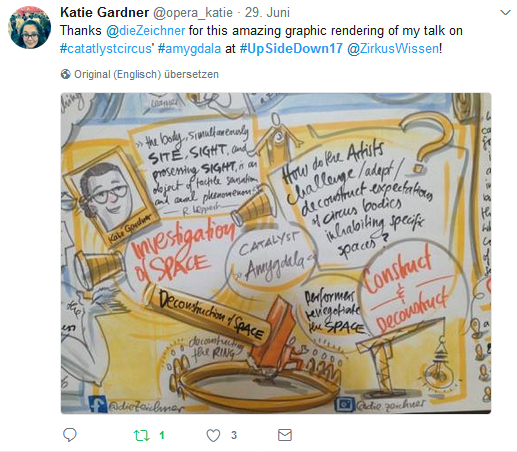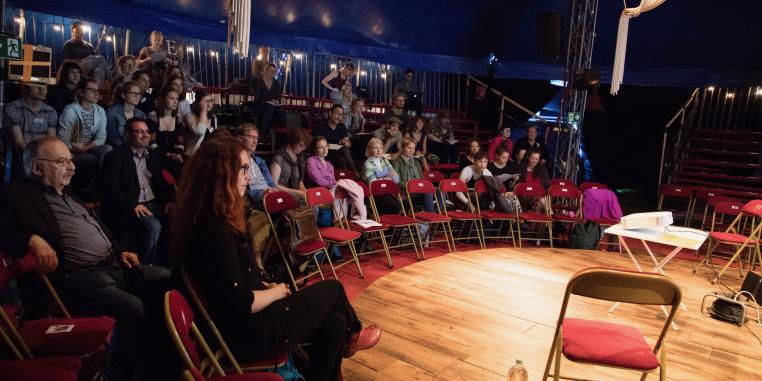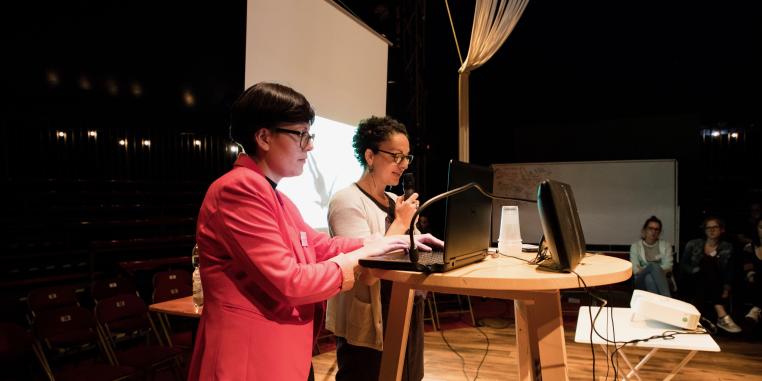Keynote | Verticality, Circularity, Gravity in Circus: Performative, Dramaturgic, Scenografic and Industrial Applications
After reviewing briefly the fundamental physiological, aesthetic and symbolic components of circus forms and performances, this presentation will focus on the roles which two creators and researchers gave to verticality, circularity and gravity in several of their contemporary circus creations.
Sandy Sun, lead ace of the trapeze, will show the place of these constants in her acrobatic, performative and choreographic writing in several of her acts (1980,1984) as well as in her pedagogy (2005).
Philippe Goudard will propose a dramaturgic and scenographic approach of several opus of his works: Le cirque intérieur is bound with the circular show, but borrows frontal and circular devices from the theatrical architectures and cirquesques; Empreintes explores the sound space of bodies, apparatus and reception of the audience; Le Cirque Nu, a scenographic, musical, sound, performative proposal, is based on a cyclic dramaturgy; Transversal Vagabond, an ultralight, adaptable circus, whose dramaturgy is based on the concepts of mobility, interculturality and adaptability, as well as on an alternative economic model, creates a wider diffusion space. Finally, the metaphor of the top and bottom will be explored in several extracts of Goudard’s own clowns works, such as Motusse and Paillasse—Clowns and Ups and downs, and in other artists’ clowns works on stage or screen.
Prof. Dr. Philippe Goudard is an artist and scientist of the circus arts. He has created and performed over forty original contemporary circus works. As a medical doctor he is the former leader of the medical department of the French Centre National des Arts du Cirque and has been involved for years in the health problems of circus artists. As a professor of performing arts at Université Paul-Valéry Montpellier III in France, he created and leads the only circus research program at a French university, Circus: history, imaginary, practices. He is the author of many relevant publications in circus studies.
Sandy Sun was awarded the gold medal in trapeze at the Festival Mondial du Cirque de Demain and was awarded a prize by the Foundation Marcel Bleustein-Blanchet. Sun has created her very own style involving contemporary choreography and the virtuosity of the classic apparatus in trapeze. She is a virtuoso soloist in the biggest circuses and European cabarets, teaches at high level professional circus schools, communicates her art through her graduate level classes and gives talks at scientific conferences in the international circus network.

Keynote | Netherspaces; Collaborative Spaces: Performance Research and Circus Practice
There are performance spaces—circular, focalized, observed by audiences who occupy their own active spaces of reception. There are discursive spaces, aesthetic postures, institutional positions. There are spaces aligned horizontally or vertically according to scenographic or acrobatic logic. There are spatial mobilities of families and clans and circus professionals. But what of the “netherspace” of academic inquiry which flirts with creation; what space can we allow for research-creation as seen through the scope of action-research? Can such a space resist dilettantes and creators in search of a venue? Must such a space resist them? What space can one define for research that isn’t strictly academic, nor industrial in ambition, but that allows for the study of processes while acknowledging a constructive contamination of this study space by its very self-reflexivity and agency?
Through my current explorations in the poetics and circus of circus dramaturgy in the context of the National Circus School in Montreal and other recent explorations with other companies and artists, I’ll attempt to define and perhaps defend a space for pure, experimental research as it can benefit industry and artistry no doubt, but also as it can become its own sustained performative act.
Prof. Dr. Louis Patrick Leroux is a professor at Concordia University and the Founder and Director of the Montreal Working Group on Circus Research. He holds a strong interest in circus, stemming from his practical experience in theatre and scholarly research into discourse analysis and the performing arts. Leroux has published and given international talks on contemporary circus, and has worked closely with the Québec circus scene as a researcher, collaborator and teacher. He is an ongoing associate researcher and guest teacher at the National Circus School of Montreal. At the NSC he is currently working alongside students and teachers exploring the various modes of circus narratives and dramaturgical strategies. Recent scholarly collections include Cirque Global: Québec’s Expanding Circus Boundaries, coedited with Charles Batson (McGill-Queen’s UP, 2016).
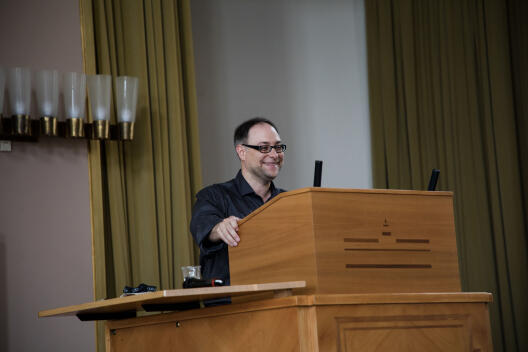
Performance Analysis and Space
Franziska Trapp and Prof. Dr. Maren Conrad | Circus and Space – A Semiotic of Performance
In her first Open Letter to the Circus, contemporary circus dramatist Bauke Lievens writes: “Circus acts always interrupt the narrative. It is simply not possible to combine the two in one smooth whole. At the moment of physical danger (of presence), the story (the representation) simply stops.” Success or failure of circus narration crucially depends on the success or failure of movement through space and interaction with this space, i.e., it depends on the performance of an acrobat. In the moment of failure, the circus performance ultimately refers back to itself, because its media-specific materiality is foregrounded, laying bare an aesthetics of risk. In stark contrast to literary and filmic artefacts, space itself is the main premise of the performance, thus functioning as the central enabling constituent for the construction of the circus as a secondary semiotic system in the sense of Jurij M. Lotman. This paper regards the movement of the acrobat through the stage space as constantly threatened by failure, and seeks to conceptualize this specific form of spatial interaction, which leads to the emergence of narrative and meaning through its successful completion.
Prof. Dr. Maren Conrad studied German literature and media, Scandinavian culture, and psychology from 2004-2008 at Kiel University, Germany. From 2008 to September 2011, she was a lecturer at the Institute for German Literature and Media at Kiel University and wrote her PhD thesis, which deals with the rise of the fantastic in German ballads. In 2011/12 she worked as a DAAD-lecturer at the Department of German at University College Cork, Ireland. From 2012-2017 she was the coordinator of the Graduate School “Practices of Literature” and Postdoc at the college “Literaturtheorie als Theorie der Gesellschaft” at the University of Münster. Since April 2017 she has been a full-time professor of German literature at the University of Erlangen-Nürnberg.
Franziska Trapp, PhD candidate in Cultural Poetics at the University of Münster and the University of Montpellier, is working on the narrativity of circus. She is at the forefront of circus studies in Germany, founder of the research project Zirkus | Wissenschaft and organizer of the international conferences “Semiotics of the Circus” (2015) and “UpSideDown—Circus and Space” (2017). During the last years, Trapp has worked for various circus productions, such as the Festival Mondial du Cirque de Demain in France and Cirque Bouffon in Germany.
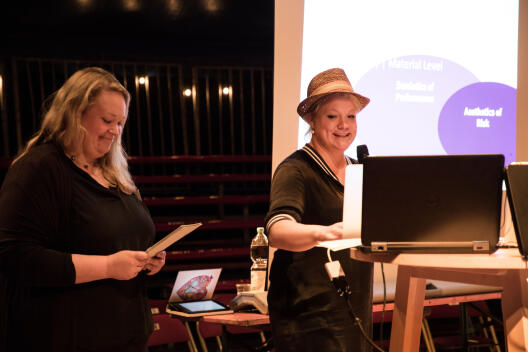
Dr. Anne Hemkendreis | “Between the Lines”: On the Capability of the Body to Draw in Space
The term “alignment” is central to contemporary circus. When put into a historical context, it marks an aesthetic category, referring to the dependency, connection and division of subject and space. Two major concepts of space underlie this assumption: the architectonic space, on the one hand, and the performative space, on the other, which includes the viewer as a creating force. But what happens when physical lines and spatial vectors become a playground of contortion, displacement and rotation in contemporary circus performances? Is this a manifestation of classical ideas of beauty in an ideal space or does it signify a broken and disoriented body? Could the redefinition of alignment and the play with its form serve the purpose of including circus art into an aesthetic development in which the line becomes a symbol of the transcendent (Antiquity/Medieval Times), of excess and splendor (Pre-modern Times), of inwardness and infinity (Modern Times) and lastly of abstraction, thereby always reflecting the relation between human beings and their surroundings?
Based on the methods of image research and dance studies this paper wants to explore the conscious utilization of the line in artistic performances in its faculty to define the body in space, while putting a special focus on the actual circus scene of Berlin. In doing so, the three major characteristics, meaning the curve, the angle and the straight line, are being taken into consideration regarding the dissolution of inside vs outside, body vs space and shape vs form. This leads to the assumption of an intended shift of the viewers’ perception from a manifestation of the artistic body as an ideal or broken character on the one side and the body’s potential to extend in an infinite space beyond any limitation or rational definition on the other.
This becomes clear for example in Ana Jordao’s performance “Between the lines”. Here, the rope is not used to undertake supreme tricks but to scrutinize its ability to signify gravity, coordination and direction. In one of the first sequences, the rope becomes a staircase which the artist uses to climb up and down simultaneously. This main feature of the circus (as world being put upside down) is further exemplified in the rope being arranged as a circle. Thus, it reinterprets the theatre stage as a circus ring while at the same time it is used by the artist to walk out its inner scale. Lastly, being postured as the outline of a body, the viewer is reminded of a missing person and directly entangled into a question of presence and absence. To sum it up, this paper explores the fundamental challenge of our understanding of reality in reference to the body’s relation to space, as one of the major topics of contemporary circus. Consequently, it inquires into the cultural and aesthetic conditioning of our perception.
Dr. Anne Hemkendreis studied art history and German in Bochum and Dublin. Her dissertation was on the Danish painter Vilhelm Hammershøi and published in 2016. She currently works as an academic assistant and lecturer at the Leuphana University of Lüneburg, Germany. Meanwhile, she has also started to train hula hoop, fire and aerial arts, and to organize a variety of shows, festivals and conferences. Hemkendreis lives in Berlin and combines her life as a researcher and performer by writing and teaching about the contemporary circus scene and its origin.
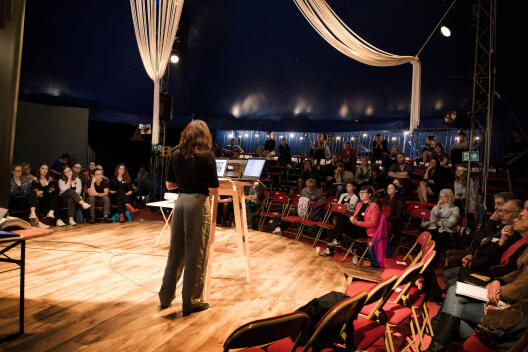
Sebastian Belmar | Understanding Circus Performance as an Art of Space
What kind of space is produced by contemporary circus production? Space for acts of resistance or for art hybridization? Ever since the theory of relativity was published a new conception of time and space was established, modifying art production into vertiginous levels of creation. These ideas were crystallized, for instance, at the Bauhaus School, where Oskar Schlemmer arrived in 1920 and considered ideas of harmony between sounds and colours in the same way as Kandinsky and Shomberg. To complete his work, he used the new technologies associated with the universal law of art appearing from the measure and rhythm of the human body. To reconsider scenic representation, he used popular elements from the music hall: cirque, cabaret acrobats, marionettes, etc. His work considered scenic phenomena as a place to crystallize the arts. The mathematics of the body reveals the corporal dynamic of movement, entering the fields of gymnastics and acrobatics. If we imagine that we could see the impression left in space by the trajectories of the moving body, we could appreciate a plastic representation in which we could expand the plane surface of the grown into a consideration of a sterometrical space. Laban also represented this conceptual idea during the same period. His achievements in the fields of movement notation, choreography and the architecture of the body in movement help us to communicate movement experience.
If we consider the ideas expressed by Schlemmer about scenic performance, this should be considered as an art of absolute precision, presenting the latest technologies: mobile stage (horizontal and vertical), turning stage, moving ground (like running machines), elevators, mapping projections, etc. Most important is how the different space data, height, width and length are combined and connected with the measure of the bodies on the stage, and how the movement trajectories create different tensions and dramas in space. Space is composed of different forces, material and times to become the genesis of an architectonic movement, which can be better developed within the open boundaries of circus.
After discussing the circle phenomenology, the different attitudes become apparent, such as the one from Johan le Guillerm of Cirque ici, who defends the position that the circle is the natural form of human gathering and that it is not possible to think of the circus outside of the circular configuration. However, present day circus performance has proven its adaptability, offering different possible representations: it may be site-specific, or take place in a theatre or cinema, among others. Most importantly, this place of representation offers the possibility of questioning and creating different spaces, of going even further than 3D consideration, capable of producing a spherical space of presentation, almost in levitation. These possibilities can only be explored by a special kind of body.
After investigating the formation of circus performance, it is striking how this specific technique not only develops a physicality which is able to explore the limits of human movement in different spatial configurations, but also questions the psychological limits of humans facing risk: falling, vertigo or even death. A specific kind of dramaturgy might emerge as evidence of this dilemma. This problem, which has become a focus of interest of our days could be considered in light of specific parameters which are fundamental to circus language: Verticality, equilibrium and repulsion. These physical notions define physical and psychological engagement and are also necessary to discover different transpositions, to develop a poetic representation, to compose the dramatic plot of a given creation. This point opens up the possibility to present, explore and discuss different creative processes, such as Aurelien Bory (Cie 111) and his trilogy (IJK, Plan B and Plus ou moins l’infini), Kitsou Dubois, Martin Zimmerman, among others.
Sebastian Belmar is a movement and creation teacher at Centre des Arts du Cirque Balthazar and at ENSAD Escole National des Arts Dramatiques de Montpellier. Belmar studied architecture and circus techniques at the National School of Circus, Rio de Janeiro, and at the International School of Theatre of Jacques Lecoq, Paris. Belmar’s work as choreographer reflects his knowledge of architecture and movement in the field of circus performance. Most of his creations have been developed in collaboration with other international artists such as David Zambrano, Ultima Vez, Dot 504 and Royal de Luxe, among others.
Helen Empling | Aerial Rope, Vertical Impact. From Ballet to Parkour, Vertical Nomads
Circus semantics have evolved in recent years following new trends and types of apparatus. In aerial terms, the notion of “verticals” has emerged, which encompasses “tissu” alias aerial silk or aerial fabric, “corde lisse” alias the rope and the various forms of multicordes; moreover, there is also the hanging pole and the Chinese pole. Another recently identified and designated aerial category is that of “single points aerials”, which includes, among others, “lyra” alias aerial ring, dance trapeze, straps and the aforementioned verticals (except the Chinese pole). How does this new terminology resonate in terms of semiotics and cultural spaces? The object of this paper will not be to itemize the protagonists of the above categories but rather to analyze the underlying philosophy of the techniques and performance styles, with an emphasis on the arguably current tenor of the genre, that is, the corde lisse.
Once upon a time—only a few decades ago when the New Circus emerged—there was the Spanish web, la Corde. Even though the stars of this art form, such as Lilan Leitzel, displayed extraordinary strength, skill and energy, this specialty was an essentially feminine, motion-assisted work, often used to cover the striking of a cage in Traditional Circus. Then came the 1991 vertical aggression of Ramon Fernandez in Metal Clown, one of the most influential acts in the evolution of the corde lisse. Contemporary rope techniques have a wide range of influences from the Indian mallakhamb to flying and swinging trapeze techniques and breakdancing, often as different interpretations of the same skill. The common space is the rope. Referents, verticality, symmetry and gravity are questioned as an intrinsic part of the rope work within a rapidly increasing search for flight and new forms of artistic expression.
A philosophy of exchange and apprenticeship has led to a nomadic culture based on what could be characterized as “Les Compagnons du Tour du Monde” as per the elite traditional apprenticeship model the “Compagnons du Tour De France”. The Tour includes international rope meetings and rope battles featuring in rock concerts. Settings are urban and natural environments, challenging norms and fear in a parkour-like perspective. This culture does not assume a specific layer of circus, traditional or contemporary. The space is the rope and its associated philosophy, defining a new minimalist nomadic architecture that transcends existing culture, generating its own cultural space. The question arises, Beyond the notion of language or art form, can specific skills or categories be considered as a cultural philosophical space within an increasingly conscious form of virtual circus architecture?
Helene Embling jumped into the circus world from civil engineering and architecture at the first opportunity, joining the opening of the French Circus Schools and becoming an instant aerialist. Works in Classical Circus in Europe led her to Australia. Her aerialist professional life since has included multiple aerial performances among others, with the Sydney and Perth International Festivals, the Dance and Theatre departments of WAAPA (Western Australian Academy or Performing Arts), NICA (National Institute of Circus Arts) and Voyage de la Vie in Singapore. She is currently undertaking a doctorate candidature with Deakin University in Melbourne. Her areas of interest are swinging trapeze and verticals with a specific interest in the transfer of the freedom of the swinging flight to the rope, combined with the motion layers of arts of movement.
Circus Practice and Space
Jimmy Gonzalez in an Interview with Riikka Juutinen | Juggling in Space
Jimmy Gonzalez, a professional circus artist with international experience, will discuss juggling and the meaning of space.
• As a juggler, you use space both vertically and horizontally. What kind of effects do the restrictions of space have on the creation process of your performances?
• How do different venues—i.e., the traditional circular stage or frontal seating arrangements—affect your performances and the creation of them?
• What do you think of the use of the juggler’s own body in the performance? How does it become a “circus body” that performs on its own terms, uses the space and interacts with the audience?
• And, simply, how do you use space in your performances to create performative spaces and meanings?
Jimmy Gonzales grew up traveling between France and Spain. At the age of eight he began to juggle and perform in the street. After many years of practicing on his own, he was accepted to the National Circus School of Châtellerault, France, and then continued his studies at the National Circus School of Montreal. Drawn to a multidisciplinary approach to the arts, he hopes to collaborate on diverse creations and experiences.
Riikka Juutinen is a graduate student of social anthropology at the University of Tampere, Finland. Riikka is currently writing her master’s thesis on circus mobilities, focusing on the mobile lifestyles of traditional circus artists. The focus of the study is the nomadic features of circus artists’ lives, as well as the conditions of artistic mobility and features of work-based movement. During the summer semester of 2017, Riikka is doing her Erasmus-internship at the University of Münster, working on Zirkus | Wissenschaft.
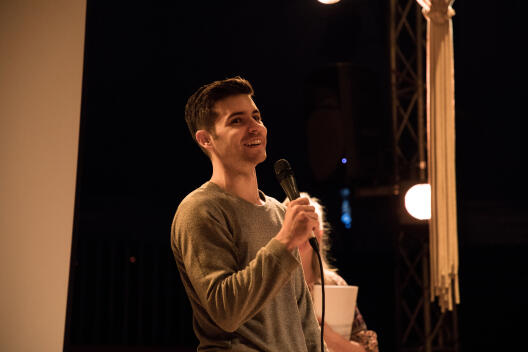
Dr. Agathe Dumont | Verticality, Gravity, Sense of Balance. Transmissions and Transfers between Dance and Circus
"To rise, to stand, to move: no movement is performed without involving gravity, without a dialogue with gravity” explains Ushio Amagastu, choreographer, pedagogue and emblematic figure of Butô dance. Whether on the ground, in the air or in weightlessness the body is always anchored to a point. Gravity is a physical phenomenon that no one can escape and it acts almost as a landmark. If the body defies gravity, it constantly brings it back to its physical reality. If someone imagines himself going higher, gravity carves his gestures and imprints its mark on his figures. Looking at two arts, dance and the circus, we could tell that they do not work in the same body or in the same spaces. The dancer will turn his attention to the horizontal, he will try to perceive the dimensions of the plateau and he will test the quality of the floor. The circus artist will raise his eyes towards the vertical, the heights of the stage, he will see above the three dimensions of space to “measure” the void.
Going further in what builds our habit of gravity we can identify “sensations” of gravity from very common gestures to high technical circus skills: something that falls from our hands, missing a step, climbing on a Chinese pole, a rope or suspended from a trapeze or a hoop. Hubert Godard theorized and analyzed this conflict between the body and gravity in order to determine the parameters, both functional and expressive, behind our posture and our gestures. From a symbolic point of view, he speaks of the construction of the gesture in a ground/sky axis determining our consciousness of the body. For him, this “dialogue with gravity” is our gravitational identity, our posture bears our history, our affects. “In each posture, in every gesture, we read the psycho-physical organization that has founded our verticality, to gravity”, says Hubert Godard.
Therefore, how far can we challenge gravity? Working in another space as circus artists usually leads to renounce, in a way, our spatial and corporeal organization. In the conquest of this otherness, the game with gravity oscillates between the fear of jumping into the void and the enjoyment of the imbalance. Through kinesthetic empathy anyone who watches (the audience watching a show, the teacher watching his/her student) faces a body that plays on its emotional ability to receive or perceive gravity. Through the words of contemporary circus artists and circus arts teachers, we will examine the perception of these stakes of perception of verticality and gravity and the ways of transmitting the “sense” of balance both from a sensitive point of view and from the point of view of movement analysis. Interviews with teachers and circus artists in the framework of their activity have shown that the approaches to these issues are diverse. Sometimes the accent will be on the anatomy and the physiological or bio-mechanical mechanisms of the body, sometimes attention will focus on sensations.
Dr. Agathe Dumont has a PhD in performing arts; she is a dancer, freelance teacher and researcher. Her theoretical and applied research focuses on dance and circus performers, especially the issue of their training. She currently teaches theory and practice in dance and circus arts (in the sport sciences and performing arts) at universities and higher artistic educational institutions. Her research has been presented at various conferences (IADMS, WDA, AFRAPS, etc.) and published in several scientific publications. She also conducts research for various cultural institutions and art schools (Académie Fratellini, CircusNext, the European Federation of Professional Circus Schools), and she recently wrote a book about a hip-hop company. At the European Federation of Professional Circus Schools, she is currently working on the INTENTS project, “Definition and recognition of the profession of circus arts teacher, continuing training and innovative educational tools”, by writing pedagogical guides containing the expertise, issues and teaching methods shared during the continuing training sessions of the project.

Dr. Stine Degerbøl | Circus, Moving Upside Down. What Does it Do to the Artist?
A poem dedicated to the man who “invented” the flying trapeze, French Jules Léotard (1838–1870), goes like this:
Off again. – Oh, what a sight! Few could jump so great a height. Still more strange, I do declare, he’s turning over in the air! There he goes, - head over heels! Don’t you wonder how he feels?
The poem seems to formulate an essence that highlights the artist’s relation to space, and capacity. Great academic research has been done on how aerial acts affect the public’s reception. The embodied sensations of the audience have been the focus, whereas this presentation would like to emphasize the embodied sensations of the artist and thereby add to research taking the artist into account as a subject.
Circus is a relevant object of research for cultural studies, including pedagogics and didactics. For this occasion, the following questions are the point of departure: Don’t you wonder how it feels to be the artist, to defy gravity, to turn upside down and to widen, deepen and heighten the three-dimensional space? Don’t you wonder how the artist feels when exploring the space? Don’t you wonder what it takes to get to achieve a movement repertoire which makes an artist an artist? Don’t you wonder what the artist might learn in addition to exploring the space? Don’t you wonder how the artist might learn to establish such a movement repertoire? Taking into account theories on embodied learning and creativity these issues will be elaborated, with some consideration of didactics.
Dr. Stine Degerbøl is the holder of a PhD from the Department of Nutrition, Exercise, and Sports at the University of Copenhagen. Her academic dissertation was titled Encountering Contemporary Circus. Exploring arts-based research methods, Degerbol seeks to understand the embodied learning of contemporary circus students.

Katie Gardner | From the Chapiteau to the Gallery: Renegotiating Spatial Constructs in Catalyst’s Amygdala
This paper will present research conducted during a collaboration with Catalyst (France) from March 20-26, 2017. The company is currently preparing their full-length piece Amygdala for an upcoming summer tour throughout Italy, and I am joining them as a researcher-in-residence during a creation intensive. The proposed paper will examine Catalyst’s creation process, present video and photographic documentation of a work-in-progress performance of Amygdala and offer a brief analysis of the research collaboration between myself and Catalyst.
Spatiality is central to the creative impetus behind Amygdala. The piece aims to situate the performers into a space that renegotiates what it means to corporeally occupy, use and deconstruct the spaces bodies inhabit and, ultimately, affect. The circus artists (Rosario Amato, Natalie Oleinik and Marina Messogiorno-Brown) explain that “the concept for this project is to cross the boundaries between circus and visual arts to create an immersive space that reflects the human presence in the natural
world.”
Drawing from Richard Leppert’s concept of the performing body as both sight and site, I am interested in the following questions: How do the artists challenge / adapt / deconstruct expectations of circus bodies inhabiting specific spaces? How do the artists construct physical and conceptual perceptions of spatiality through their corporeal use of space? What is the relationship between corporeal and non-corporeal objects in the performance space? How do the artists plan to immerse / retrain / focus the audience to perceive physical, conceptual and architectural realizations of space? What are the spatial uses of the body that reveal the circus body as a nexus for complex spatial identities? It is my aim that this research partnership with the artists of Catalyst will provide further insight into how meaning is spatially constructed and conceived during the creation period in contemporary circus arts.
Katie Gardner is a doctoral candidate in music and the Wendell Herbruck Scholar at The Queen’s College, University of Oxford. Her doctoral research investigates the musico-dramatic inclusion of aerial circus arts in contemporary opera production. As a soprano and aerialist, Gardner’s research examines circus, opera and the intersections of the two art forms. She received a MFA in voice from the California Institute of the Arts.
